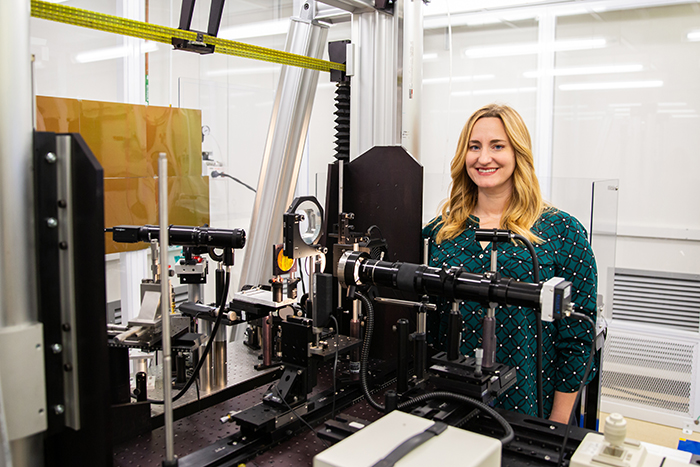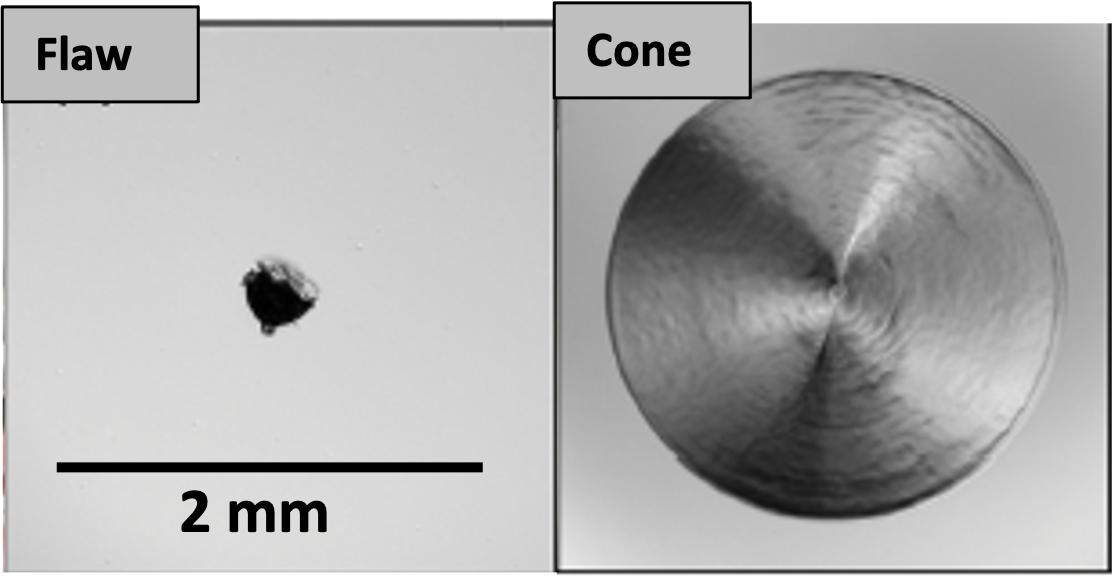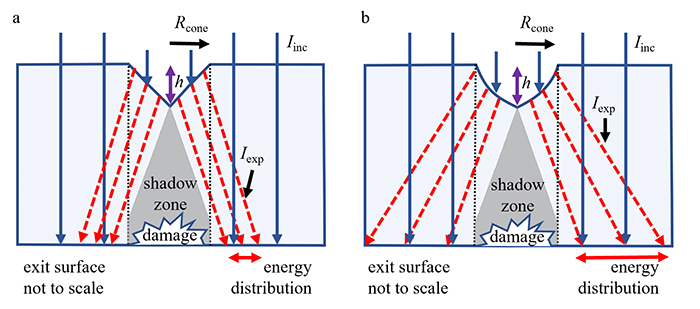Throwing Shade on Optics Damage
March 27, 2024
 LLNL staff scientist Alison Browar developed a method of creating round walled shadow cone blockers to mitigate damage growth on NIF optics that had previously been unrepairable. Credit: Mark Meamber
LLNL staff scientist Alison Browar developed a method of creating round walled shadow cone blockers to mitigate damage growth on NIF optics that had previously been unrepairable. Credit: Mark Meamber If the sun is too bright, you might don a pair of sunglasses or a hat to prevent glare from damaging your eyes. Researchers at Lawrence Livermore National Laboratory (LLNL) are using this same strategy to mitigate damage to valuable optics vital to the National Ignition Facility (NIF).
Every time NIF fires, its lasers can harm the optics along its beamlines, causing microscopic exit-surface damage. A new technique, called a shadow cone blocker (SCB), redirects laser light hitting the input surface of the optic, casting a shadow over a damage site on the exit surface to prevent it from worsening each time the laser fires.
This method reduces the size of the damage mitigation features on the optic itself, which extends the life of the optic. An advancement on this method, which will enable its use on larger damage sites, is reported in a paper, “Laser micro-machining and damage testing of rounded shadow cone blockers on silica glass for arresting laser damage growth by redirection of light,” published in Optics Express.
“This technique, a rounded walls shadow cone blocker, will enable us to mitigate damage sites on optics that our current methods can’t address,” said LLNL staff scientist Allison Browar, the paper’s first author. “We’ve proven the method for damage sites up to 1 millimeter in diameter.”
Designed to take damage
Laser damage was always part of the plan—NIF is the only laser system in the world that operates above the damage growth threshold so that it can deliver extreme laser power. Operating the laser at such high energy was instrumental in achieving fusion ignition, which LLNL has now done five times, the latest in February producing a record yield of 5.2 megajoules. This work is foundational for the Lab’s mission, with ignition enabling unprecedented capability to support the National Nuclear Security Administration’s Stockpile Stewardship Program and advance basic science research.
In the Optics Recycle Loop, damaged optics are routinely removed from NIF, repaired and returned to the laser. The microscopic damage sites cannot be repaired, but those sites can be prevented from growing when exposed to subsequent laser energy.
“There is a limit to how many repair sites can be placed on an optic,” said LLNL staff scientist Eyal Feigenbaum, the principal investigator. “The repair sites scatter away the laser light, so eventually the optic results in too much transmission reduction to be used. In other words, not enough laser light can pass through the optic. And beyond that, there are some damage sites that can’t be repaired this way.”
 Damage sites, left, are laser-machined to leave a cone shape, right, that prevents the site from growing.
Damage sites, left, are laser-machined to leave a cone shape, right, that prevents the site from growing. By ablation-based laser-machining the damaged site, the damaged material is removed, leaving a cone shape in its place—similar to how a dentist drills out a tooth’s cavity before placing a filling. This technique has limitations, especially with deeper cracks in the optic’s surface. In this case, the cone can become very wide to reach the right depth. And some cracks are too deep to repair with this method, as the cone shape must be much larger than the damage site footprint.
“Another alternative is blockers, two centimeters in diameter, that can be placed upstream on the beamline,” Feigenbaum said. “But this also comes with a high transmission reduction.”
Shadow cone blocking
The SCB involves laser-machining a cone on the input surface of the optic to deflect light away from the damage site on the exit surface. SCBs, which were first implemented on NIF in 2019, have proven effective but only for smaller damage sites.
“For damage sites approaching 1 millimeter in diameter, the shadow cone blocker creates excessive downstream laser intensification,” Browar explained.
This is because the side walls of the shadow cone send the laser light through the optic at an angle, where it interacts with the laser light coming straight through the optic. This results in more intense light around the damage site on the exit surface, creating a wide ring with higher propensity to further damage.
“We theorized that if we could change the cone shape from a conic to a parabolically rounded sidewall shape, we could mitigate the downstream intensification problem,” Browar said. “This would allow us to mitigate larger damage sites using shadow cone blockers.”
 Comparative illustration of incident (solid blue arrows) beam, Iinc, deflection by a conic SBC and conceptual rounded SCB presented here (b) creating a shadow over exit surface damage on a fused silica window. Both cones have the same radius Rcone and maximum height, h, but the deflected beam expanding wave (red dashed arrows), Iexp, for the rounded SCB differs based on cone geometry resulting in energy distribution over a larger area.
Comparative illustration of incident (solid blue arrows) beam, Iinc, deflection by a conic SBC and conceptual rounded SCB presented here (b) creating a shadow over exit surface damage on a fused silica window. Both cones have the same radius Rcone and maximum height, h, but the deflected beam expanding wave (red dashed arrows), Iexp, for the rounded SCB differs based on cone geometry resulting in energy distribution over a larger area. Putting theory into practice
While the computer models showed that the rounded walls shadow cone blocker would be effective, developing the technique to drill out the desired shape was not simple. The drilling is done by a CO2 laser that pulses to ablate material.
“Rounding the shadow cone blocker walls to the prescribed shape was done by changing the intensity in each radius,” Browar said. “Since removing material becomes nonlinear for a variety of reasons, we had to iterate to find the exact intensity in each radius.”
The researchers arrived at the right technique through a combination of experimentation and complex modeling that considered the fluence of the beam on every point of the exit surface. Modeling the interaction between the downstream laser light and the laser light deflected off the SCB was particularly challenging, as was achieving the desired SCB shape while avoiding parasitic sub-millimeter scale features that could act as microlenses and cause internal optical damage.
In lab experiments, the method has proven successful on features of up to 1 mm and is now being piloted on NIF optics.
“This has had an immediate impact,” Feigenbaum said. “We are now able to fix optics that were unrepairable with other methods.”
The next goal is to scale the technique for larger damage sites. Naturally, it’s not as easy as just making the parabolic SCB diameter larger. As more light is deflected, it could increase the interaction with the downstream light, as was the case with the straight-walled conical SCB.
“Time will tell if this is enough, or if we have to come up with more tricks,” Browar said.
Other authors on the paper are Isaac Bass, Gabe Guss, Jim Vickers, Mary Norton, and Wren Carr.
—Patricia Koning
Follow us on Twitter: @lasers_llnl



